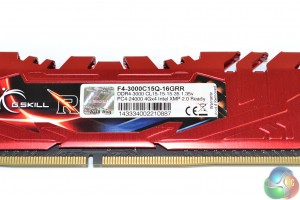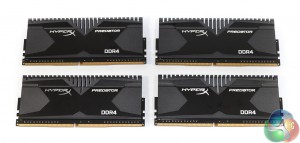Corsair Vengeance LPX 2800MHz 16GB (CMK16GX4M4A2800C16)
First up (alphabetically, that is) is Corsair's 16GB Vengeance LPX 2800MHz DDR4 memory kit. You may be asking why a set of memory rated at 2800MHz is competing in our 3000MHz group test; as already pointed out, Corsair includes a 3GHz XMP which is easy to select through a motherboard's UEFI.
Four 4GB DIMMs allow a Haswell-E CPU to take advantage of the memory in a quad-channel configuration. Memory chips are of the Hynix MFR variety in a single-sided configuration, according to a memory QVL for Asus' X99 Deluxe motherboard (a trustworthy source). That same document also suggests that different versions of the same kit may ship with Samsung-based memory chips.
We have had great experience with Hynix MFR-based memory on the DDR3 front. Our current DDR3 memory frequency record stands at 3340MHz with single-sided Hynix MFR-based ADATA XPG V2 modules. Hopefully the high frequency potential has been translated to DDR4.
I am glad to see Corsair using a low-profile heatsink for its black memory modules. The previous comb-like heatspreader used on Vengeance parts was excessively tall and caused a multitude of interference problems with CPU coolers. Factor in the low 1.20V voltage level, and a short heatspreader makes far greater sense on the DDR4 sticks.
Of course, Corsair will also have modules (Dominators) with sizable metal heatsinks that enhance cooling performance. Those modules are targeted at overclocking users, who are likely to increase voltage levels, and therefore necessitate a capable heat removal system.
Material-wise, the heatspreaders have a plastic feel about them, although they are actually a thin sheet of aluminium. The entire memory module measures in at 35mm tall.
The two XMP 2.0 configurations supported by Corsair's 2800MHz Vengeance LPX kit are:
- 2800MHz 16-18-18-36 @ 1.20V
- 3000MHz 16-18-18-39 @ 1.35V
Interest is drawn to the 2800MHz profile due to the fact that there is no way to reach a memory frequency of 2.8GHz with the default multipliers provided by a Haswell-E CPU or X99 motherboard. Corsair bypasses this issue by selecting a 125MHz base clock profile and increasing the operating base clock to 127.3MHz. This provides a 2800MHz memory frequency but it also increases the CPU, cache, and other linked clock speeds.
That's free CPU performance on one hand and increased system overclocking complexity on the other.
Dark black memory is easy to match with the vast majority of X99 motherboards currently available. Blue and red are the other heatsink colours that Corsair makes available.
As is standard in today's world, Corsair offers a lifetime warranty for the Vengeance LPX memory kit.
G.Skill Ripjaws 4 3000MHz 16GB (F4-3000C15Q-16GRR)
Today's G.Skill competitor comes from the company's Ripjaws product series. Designated Ripjaws 4 (presumably to outline the DDR4 memory chips), the four 4GB DIMMs combine to form a 16GB quad-channel kit.
Asus' memory QVL states that Hynix MFR memory chips are used on the Ripjaws 4 kit in a single-sided configuration.
Note the notch positioning for DDR4 memory modules. To avoid confusion with DDR3 DIMMs, industry made the decision to move the notch position closer to the PCB's centre. Moving the notch is a wise move, but placing it nearer the centre simply makes installing modules in the correct orientation a less simplistic procedure.
Valuing CPU cooler compatibility over questionable aesthetic improvements, G.Skill also makes uses of relatively short heatspreaders. With a height of 40mm at the tallest point, the eye-catching heatsinks only project past the DDR4 memory's PCB by 8-9mm. That's a fair trade-off for enhanced cooling potential.
Even with a 3000MHz operating frequency, the Ripjaws 4 kit that we are testing in this article is not the company's fastest part. There are 3200MHz, 3300MHz, and 3333MHz Ripjaws 4 kits, albeit with slightly looser timings, floating around the US market (UK availability is currently limited on those).
G.Skill runs that 2133MHz, 1.20V JEDEC profile for compatibility purposes and adds the 3GHz XMP configuration on top. With that XMP 2.0 profile applied, the kit will use 1.35V to operate at 3000MHz with 15-15-15-35 timings.
As the 100MHz base clock on Haswell-E only supports memory multipliers up to an operating frequency of 2666MHz, 3000MHz is reached by using a 125MHz base clock, 100:133 BCLK:DRAM ratio, and an 18x memory multiplier. That gives a 3GHz memory speed while maintaining the CPU, cache, and linked frequencies at the default (multi-core turbo) levels.
Shiny red memory goes best with a shiny red motherboard. While the colour that G.Skill decides to use for the Ripjaws 4 clearly isn't as neutral as black, there are plenty of motherboards that match the red G.Skill colour scheme effectively. The company is also keeping to its long-served tradition of providing red-coloured memory modules.
If you prefer modules of a different colour, you'll either have to opt for black heatspreaders or go down the frequency hierarchy in search of blue.
It almost goes without saying that G.Skill covers the 3000MHz Ripjaws 4 kit with a lifetime warranty.
Kingston HyperX Predator 3000MHz 16GB (HX430C15PB2K4/16)
Given flagship status in Kingston's DDR4 memory catalogue, the HyperX Predator modules use four 4GB DIMMs to provide a 16GB total capacity and quad-channel capability.
A single-sided PCB layout is also adopted by Kingston, and Hynix MFR memory chips seem to be deployed.
Kingston continues to use the eye-catching fin design that is so easily linked to the company's HyperX memory products. If I had to pick the kit that I find most attractive, that honour would go to Kingston. But there's compromise to be made for that enhanced appearance; height.
At 55mm-tall, Kingston's memory modules take all of the positive feedback I have given for Corsair and G.Skill's dimensional choices, and thrown it out of the window. CPU cooler interference is going to be an all-too-common issue with the (arguably) oversized HyperX Predator heatspreaders, especially on an X99 board where memory sits either side of the CPU socket.
Conversely, many enthusiasts may argue with me and state that the tall heatspreaders improve their system's aesthetics. Perhaps the best explanation for Kingston's decision to use such heavyweight heatsinks is tied to the memory's XMP voltage of 1.50V (which, since our testing, has been reduced to 1.35V on all current kits).
At 25% higher than the 1.20V JEDEC level, Kingston may have been opting for reliability by using a heatsink configuration that can capably dissipate the added energy. More on that voltage point in the next section.
As is the case with Corsair and G.Skill, Kingston uses the 2133MHz JEDEC profile for compatibility purposes. The XMP 2.0 setting operates at 3000MHz with 15-16-16-39 timings and a voltage of 1.35V (although our older sample used 1.50V, but will not reach market at that level). 3GHz on the memory clock is reached in an identical fashion to G.Skill's kit; the base clock and multiplier adjustments seem to be consistent amongst motherboard and memory vendors across the industry.
Kingston also throws in a 2666MHz XMP configuration for good measure, although this frequency can be easily applied through most motherboard UEFI systems.
We have to highlight the voltage point and how bad a decision it was. 1.50V is excessive, not to mention potentially detrimental to product lifespan, especially given that all competing vendors are running up to 1.35V with stability. A lower voltage level used in the initial design may have led to other follow-on changes (which may have been positive or negative).
That said, it is positive to see that Kingston has already listened to feedback and reduced the voltage level to a sensible 1.35V. And there is the argument for overclockers who now know that the kit's heatsinks and ICs can handle high voltage levels.
I have already outlined my affection for the appearance of Kingston's HyperX Predator memory modules. The black colour is very easy to match with other components. However, our motherboard installation shot highlights the extent to which CPU cooler clearance around the socket area is limited by the modules.
Just like the other two competitors on show today, Kingston also provides a lifetime warranty for its memory.
 KitGuru KitGuru.net – Tech News | Hardware News | Hardware Reviews | IOS | Mobile | Gaming | Graphics Cards
KitGuru KitGuru.net – Tech News | Hardware News | Hardware Reviews | IOS | Mobile | Gaming | Graphics Cards















I AM IN IT TO WIN IT GREAT MEMORY
Thanks KitGuru – been struggling to work out how to get my Corsair 4 x 4GB 2800MHz to play ball in my Rampage V – just the article I needed to get my head around the XMP settings 🙂
Is there any real difference between DDR3 and DDR4 that would justify to get DDR4 for a new rig right now despite the difference in price ?
You don’t have a choice if you plan on building an X99 system. It only uses DDR4 memory modules and you can’t use DDR4 on Z97 and older mainstream motherboards. But if you mean Z97 with DDR3 vs X99 with DDR4, then their is real and significant performance difference.
yes, I meant Z97+DDR3 vs Z99+DDR4, especially for games.